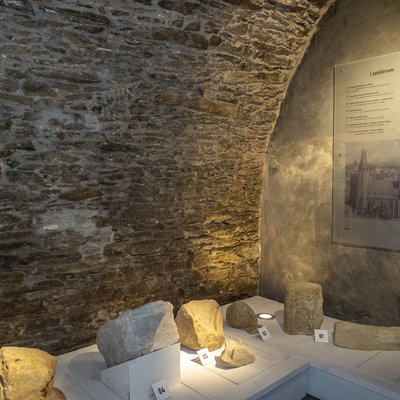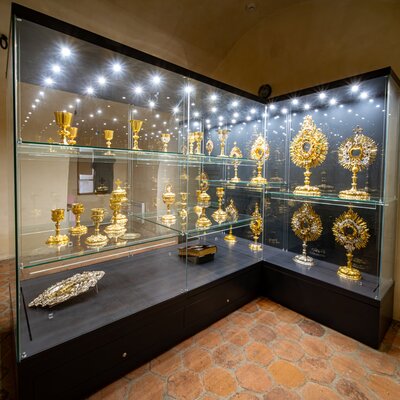Belfry
Independently standing belfry from the beginning of 16th century. In the basement you can visit a Lapidarium, on the first floor the restored church treasure is displayed and from the outer gallery you can admire the view of the town.
History
The late-gothic belfry from the beginning of 16th century was reconstructed several times in connection with the fires which affected it at the end of 18th century and in the second half of 19th century. The present-day look is the result of purist reconstruction from 1872.
Treasure house of Roman-Catholic Parish in Kolín
The room on the elevated ground-floor of St. Bartholomew´s belfry has served its purpose of storing valuables probably since its foundation at the beginning of 16th century. Nowadays a part of church treasure of Roman-Catholic church of Kolín is displayed in this area. It includes a collection of valuable historic objects and vessels from gilded silver used either for masses (liturgy) or cult (devotio).
The core is formed by objects from the treasure house of St. Bartholomew´s church in Kolín. A numerous collection of these objects from 17th-20th century has been preserved, however, the amount is just a fragment of past dazzling beauty which served for celebration of God as well as for expression of personal piousness and gratefulness of many generations of Kolín citizens.
Even though the treasure of St. Bartholomew´s Church was collected from 13th century, it repeatedly became a goal of war plundering, religious reform movements and changes of the style of that time. So we get records about its oldest jewels from Gothic and Renaissance period only from written sources. Nowadays, its base is formed especially by Baroque and Classicist monuments. However, even those were in danger as the church silver had to be handed over to the Austrian empire. During the economic crisis in 1810 a lot of valuable pieces of arts and crafts were destroyed with the purpose of gaining valuable metal for state needs.
Currently, also sacred vessels used in other churches within Kolín parish area form a part of the treasure house. It concerns for example liturgical tools formerly used in St. Bartholomew´s Church in Býchory, The Church of the Assumption in Kbel, The Church of St. Venceslaus and Corpus Cristi in Křečhoř, The Church of St. George in Lošany, The Church of St. Peter and Paul in Nebovidy, The Church of St. Venceslaus in Nová Ves, The Church of St. James the Great in Ovčáry, The Church of the Assumption in Předhradí, The Church of St. Andrew in Starý Kolín or The Church of the Visitation of Our Lady in Veltruby.
01 Reliquary of St. John of Nepomuk from St. Bartholomew´s Church in Kolín
Half of 18th century
02 Reliquary of St. Cross from St. Batrholomew´s Church in Kolín
Half of 18th century
03 Monstrance from The Church of St. Venceslaus and Corpus Cristi in Křečhoř
Half of 19th century
04 Cruets
End of 19th century
05 Monstrance
Half of 19th century
06 Monstrance from The Church of the Assumption in Předhradí
End of 18th century
07 Monstrance from The Church of St. Venceslaus in Nová Ves
Half of 18th century
08 Monstrance
End of 19th century
09 Chalice of Baron Franz Trenck
Controversial military commander and adventurer Franz, free man von der Trenck († 1749) had the Rococo chalice made in Old Town in Prague. The chalice was made as thanks for healing the injury of his left leg caused by a cannon shot. He was shot on 14 November 1744 in Kolín during the conquering the town occupied by the Prussian army.
1744
10 Chalice of Martin Pezzorides from St. Batholomew´s Church in Kolín
1690
11 Chalice from St. Bartholomew´s Church in Býchory
Around the year 1900
12 Chalice
1895
13 Ciborium from The Church of the Assumption in Kbel
End of 18th century
14 Missal from St. Bartholomew´s Church in Kolín
1735, the binding from second quarter of 18th century
15 Chalice of Anna Ašulínová (Vašulínová?) from The Church of the Immaculate Conception of Virgin Mary in Jezeřany
16 Ciborium (originally a chalice) from The Church of St.Venceslaus and Corpus Cristi in Křečhoř
17 Ciborium from St. Bartholomew´s Church in Kolín
Half of 18th century
18 Candlestick of guild of butchers from St. Bartholomew´s Church in Kolín
Half of 18th century
19 Chalice from The Church of St.James the Great in Ovčáry
1524
20 Chalice from The Church of St. George in Lošany
Half of 16th century
21 Chalices of František Bohuslav Šperlink from Kolín parish
Collection of four Baroque chalices was made for the needs of Kolín parish from the legacy of the primate and wealthy townsman František Bohuslav Šperlink († 1722) buried in Šperlinkovská chapel of St.Bartholomew´s Church.
1722
22 Chalice of Judita Prošovská from The Church of St. Vitus in Kolín
1718
23 Archiepiscopal chalice from St. Bartholomew´s Church in Kolín
Around the year 1690
24 Ciborium from St. Bartholomew´s Church in Kolín
1797, modified in first quarter of 20th century
25 Chalice from Capuchin Church of the Holy Trinity in Kolín
1832
26 Big monstrance from St. Bartholomew´s Church in Kolín
1756
27 Monstrance from The Church of St. George in Lošany
Around the year 1700, completed in half of 18th century
28 Monstrance
Half of 18th century
29 Monstrance from The Church of St. Andrew in Starý Kolín
Half of 18th century
Lapidarium
The Lapidarium including historic and architectonic parts from St.Bartholomew´s Church and other buildings in the church grounds was created in the vault of the belfry in 2020. The Lapidarium presents mainly original gothic architectonic parts which were changed during the church reconstruction in the second half of 19th century and then freely displayed in the area of neighbouring wall outer bailey. Some features were later installed into the support walls near the city walls where they can be found today. Other medieval fragments were found in 2004-2020 during the reconstruction of the church and its adjacent buildings.
The most significant stone feature is the collection of early-gothic capitals of vault support from the second half of 13th century and a part of pinnacle from the supportive system of late-gothic choir-loft from the second half of 14th century. The unique features are the fragments of the original stone decoration of Parléř´s pastoforium (a case for depositing and displaying The Blesses Sacrament) from about 1370.


.jpg?locale=en)
.jpg?locale=en)
.jpg?locale=en)
.jpg?locale=en)
.jpg?locale=en)




.jpg?locale=en)
.jpg?locale=en)
.jpg?locale=en)
.jpg?locale=en)
.jpg?locale=en)
.jpg?locale=en)
.jpg?locale=en)
.jpg?locale=en)
.jpg?locale=en)



